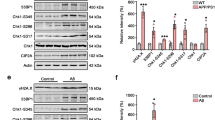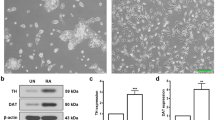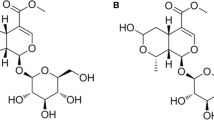Abstract
The pathological characteristics of Alzheimer’s disease (AD) include formation of senile plaques resulting from amyloid-β (Aβ) deposition and neurofibrillary tangles caused by tau hyperphosphorylation. Reducing tau hyperphosphorylation is crucial for treatment of AD. Network pharmacology analysis showed that CTS may reduce tau hyperphosphorylation by regulating the phosphatidylinositol 3 kinases/protein kinase B/ glycogen synthase kinase-3β (PI3K/Akt/GSK3β) pathway. We investigated the ability of cryptotanshinone (CTS) to reduce Aβ-induced tau hyperphosphorylation and characterized the underlying mechanisms. Amyloid-β42 oligomers (AβO) were used to establish an AD model in HT22 cells. The expression levels of tau and related proteins in PI3K/Akt/GSK3β pathway were measured using western blot and immunofluorescence staining. The above-mentioned proteins were then evaluated in an okadaic acid (OKA)-induced AD cell model to verify the results. Synapse-associated proteins including post-synaptic density protein-95 (PSD95) and synaptophysin were also evaluated. We found that CTS significantly reduced tau hyperphosphorylation at Ser202, Ser404, Thr181, and Thr231 in AβO- and OKA-induced cell models. Moreover, we also found that CTS reversed AβO-induced reductions in the levels of PSD95 and synaptophysin. We used LY294002 to block PI3K and the results showed that CTS exerted neuroprotective effects through regulation of the PI3K/Akt/GSK3β signaling pathway. In summary, we showed for the first time that CTS inhibited AD-related tau hyperphosphorylation and reduced the effects of AβO on the expression levels of PSD95 and synaptophysin via the PI3K/Akt/GSK3β pathway in HT22 cells.






Similar content being viewed by others
Data Availability
The datasets generated during and/or analyzed during this study are available from the corresponding author upon reasonable request.
References
Patterson C, International AsD (2018) World Alzheimer report 2018. Alzheimer’s Disease International
Cummings J, Lee G, Ritter A, Sabbagh M, Zhong K (2020) Alzheimer’s disease drug development pipeline: 2020. Alzheimer’s Dement 6(1):e12050. https://doi.org/10.1002/trc2.12050
Kidd M (1963) Paired helical filaments in electron microscopy of Alzheimer’s disease. Nature 197:192–193. https://doi.org/10.1038/197192b0
Glenner GG, Wong CW (1984) Alzheimer’s disease: initial report of the purification and characterization of a novel cerebrovascular amyloid protein. Biochem Biophys Res Commun 120(3):885–890. https://doi.org/10.1016/s0006-291x(84)80190-4
Liu PP, Xie Y, Meng XY, Kang JS (2019) History and progress of hypotheses and clinical trials for Alzheimer’s disease. Signal Transduct Target Ther 4:29. https://doi.org/10.1038/s41392-019-0063-8
Bloom GS (2014) Amyloid-β and tau: the trigger and bullet in Alzheimer disease pathogenesis. JAMA Neurol 71(4):505–508. https://doi.org/10.1001/jamaneurol.2013.5847
Götz J, Chen F, van Dorpe J, Nitsch RM (2001) Formation of neurofibrillary tangles in P301l tau transgenic mice induced by Abeta 42 fibrils. Science (New York, NY) 293(5534):1491–1495. https://doi.org/10.1126/science.1062097
Avgerinos KI, Ferrucci L, Kapogiannis D (2021) Effects of monoclonal antibodies against amyloid-β on clinical and biomarker outcomes and adverse event risks: A systematic review and meta-analysis of phase III RCTs in Alzheimer’s disease. Ageing Res Rev 68:101339. https://doi.org/10.1016/j.arr.2021.101339
Oddo S, Caccamo A, Shepherd JD, Murphy MP, Golde TE, Kayed R, Metherate R, Mattson MP et al (2003) Triple-transgenic model of Alzheimer’s disease with plaques and tangles: intracellular Abeta and synaptic dysfunction. Neuron 39(3):409–421. https://doi.org/10.1016/s0896-6273(03)00434-3
Busche MA, Hyman BT (2020) Synergy between amyloid-β and tau in Alzheimer’s disease. Nat Neurosci 23(10):1183–1193. https://doi.org/10.1038/s41593-020-0687-6
Roberson ED, Scearce-Levie K, Palop JJ, Yan F, Cheng IH, Wu T, Gerstein H, Yu GQ et al (2007) Reducing endogenous tau ameliorates amyloid beta-induced deficits in an Alzheimer’s disease mouse model. Science (New York, NY) 316(5825):750–754. https://doi.org/10.1126/science.1141736
Vossel KA, Zhang K, Brodbeck J, Daub AC, Sharma P, Finkbeiner S, Cui B, Mucke L (2010) Tau reduction prevents Abeta-induced defects in axonal transport. Science (New York, NY) 330(6001):198. https://doi.org/10.1126/science.1194653
Arboleda-Velasquez JF, Lopera F, O’Hare M, Delgado-Tirado S, Marino C, Chmielewska N, Saez-Torres KL, Amarnani D et al (2019) Resistance to autosomal dominant Alzheimer’s disease in an APOE3 Christchurch homozygote: a case report. Nat Med 25(11):1680–1683. https://doi.org/10.1038/s41591-019-0611-3
Su CY, Ming QL, Rahman K, Han T, Qin LP (2015) Salvia miltiorrhiza: Traditional medicinal uses, chemistry, and pharmacology. Chin J Nat Med 13(3):163–182. https://doi.org/10.1016/s1875-5364(15)30002-9
Jia Q, Zhu R, Tian Y, Chen B, Li R, Li L, Wang L, Che Y et al (2019) Salvia miltiorrhiza in diabetes: A review of its pharmacology, phytochemistry, and safety. Phytomedicine 58:152871. https://doi.org/10.1016/j.phymed.2019.152871
Guo Y, Li Y, Xue L, Severino RP, Gao S, Niu J, Qin LP, Zhang D et al (2014) Salvia miltiorrhiza: an ancient Chinese herbal medicine as a source for anti-osteoporotic drugs. J Ethnopharmacol 155(3):1401–1416. https://doi.org/10.1016/j.jep.2014.07.058
Qin Y, Zheng B, Yang GS, Yang HJ, Zhou J, Yang Z, Zhang XH, Zhao HY et al (2020) Salvia miltiorrhiza-Derived Sal-miR-58 Induces Autophagy and Attenuates Inflammation in Vascular Smooth Muscle Cells. Mol Ther Nucleic Acids 21:492–511. https://doi.org/10.1016/j.omtn.2020.06.015
Wu CF, Bohnert S, Thines E, Efferth T (2016) Cytotoxicity of Salvia miltiorrhiza Against Multidrug-Resistant Cancer Cells. Am J Chin Med 44(4):871–894. https://doi.org/10.1142/s0192415x16500488
Wu YH, Wu YR, Li B, Yan ZY (2020) Cryptotanshinone: A review of its pharmacology activities and molecular mechanisms. Fitoterapia 145:104633. https://doi.org/10.1016/j.fitote.2020.104633
Wong KK, Ho MT, Lin HQ, Lau KF, Rudd JA, Chung RC, Fung KP, Shaw PC et al (2010) Cryptotanshinone, an acetylcholinesterase inhibitor from Salvia miltiorrhiza, ameliorates scopolamine-induced amnesia in Morris water maze task. Planta Med 76(3):228–234. https://doi.org/10.1055/s-0029-1186084
Zhang F, Zheng W, Pi R, Mei Z, Bao Y, Gao J, Tang W, Chen S et al (2009) Cryptotanshinone protects primary rat cortical neurons from glutamate-induced neurotoxicity via the activation of the phosphatidylinositol 3-kinase/Akt signaling pathway. Exp Brain Res 193(1):109–118. https://doi.org/10.1007/s00221-008-1600-9
Mei Z, Zhang F, Tao L, Zheng W, Cao Y, Wang Z, Tang S, Le K et al (2009) Cryptotanshinone, a compound from Salvia miltiorrhiza modulates amyloid precursor protein metabolism and attenuates beta-amyloid deposition through upregulating alpha-secretase in vivo and in vitro. Neurosci Lett 452(2):90–95. https://doi.org/10.1016/j.neulet.2009.01.013
Maione F, Piccolo M, De Vita S, Chini MG, Cristiano C, De Caro C, Lippiello P, Miniaci MC et al (2018) Down regulation of pro-inflammatory pathways by tanshinone IIA and cryptotanshinone in a non-genetic mouse model of Alzheimer’s disease. Pharmacol Res 129:482–490. https://doi.org/10.1016/j.phrs.2017.11.018
Mei Z, Situ B, Tan X, Zheng S, Zhang F, Yan P, Liu P (2010) Cryptotanshinione upregulates alpha-secretase by activation PI3K pathway in cortical neurons. Brain Res 1348:165–173. https://doi.org/10.1016/j.brainres.2010.05.083
Mei Z, Yan P, Situ B, Mou Y, Liu P (2012) Cryptotanshinione inhibits β-amyloid aggregation and protects damage from β-amyloid in SH-SY5Y cells. Neurochem Res 37(3):622–628. https://doi.org/10.1007/s11064-011-0652-6
Wu JS, Meng QY, Shi XH, Liu LX, Zhang ZK, Guan HS, Shao CL, Wang CY (2020) The oxygenated products of cryptotanshinone by biotransformation with Cunninghamella elegans exerting anti-neuroinflammatory effects by inhibiting TLR 4-mediated MAPK signaling pathway. Bioorg Chem 104:104246. https://doi.org/10.1016/j.bioorg.2020.104246
Durairajan SS, Liu LF, Lu JH, Koo I, Maruyama K, Chung SK, Huang JD, Li M (2011) Stimulation of non-amyloidogenic processing of amyloid-β protein precursor by cryptotanshinone involves activation and translocation of ADAM10 and PKC-α. J Alzheimer’s Dis 25(2):245–262. https://doi.org/10.3233/jad-2011-102085
Lu M, Zhou Y, Li X, Sun Q, Guo J, Wu B, Wu M (2021) Research on regularity of traditional Chinese medicine in treatment of Alzheimer’s disease based on data mining. China J Chin Mater Med 46(06):1558–1563. https://doi.org/10.19540/j.cnki.cjcmm.20200611.502
Ru J, Li P, Wang J, Zhou W, Li B, Huang C, Li P, Guo Z et al (2014) TCMSP: a database of systems pharmacology for drug discovery from herbal medicines. J Cheminform 6:13. https://doi.org/10.1186/1758-2946-6-13
Piñero J, Bravo À, Queralt-Rosinach N, Gutiérrez-Sacristán A, Deu-Pons J, Centeno E, García-García J, Sanz F et al (2017) DisGeNET: a comprehensive platform integrating information on human disease-associated genes and variants. Nucleic Acids Res 45(D1):D833-d839. https://doi.org/10.1093/nar/gkw943
Zhang H, Jia L, Jia J (2020) Oxiracetam Offers Neuroprotection by Reducing Amyloid β-Induced Microglial Activation and Inflammation in Alzheimer’s Disease. Front Neurol 11:623. https://doi.org/10.3389/fneur.2020.00623
Razani E, Pourbagheri-Sigaroodi A, Safaroghli-Azar A, Zoghi A, Shanaki-Bavarsad M, Bashash D (2021) The PI3K/Akt signaling axis in Alzheimer’s disease: a valuable target to stimulate or suppress? Cell Stress Chaperones 26(6):871–887. https://doi.org/10.1007/s12192-021-01231-3
Singh AK, Kashyap MP, Tripathi VK, Singh S, Garg G, Rizvi SI (2017) Neuroprotection Through Rapamycin-Induced Activation of Autophagy and PI3K/Akt1/mTOR/CREB Signaling Against Amyloid-β-Induced Oxidative Stress, Synaptic/Neurotransmission Dysfunction, and Neurodegeneration in Adult Rats. Mol Neurobiol 54(8):5815–5828. https://doi.org/10.1007/s12035-016-0129-3
Gabbouj S, Ryhänen S, Marttinen M, Wittrahm R, Takalo M, Kemppainen S, Martiskainen H, Tanila H et al (2019) Altered Insulin Signaling in Alzheimer’s Disease Brain - Special Emphasis on PI3K-Akt Pathway. Front Neurosci 13:629. https://doi.org/10.3389/fnins.2019.00629
Seshacharyulu P, Pandey P, Datta K, Batra SK (2013) Phosphatase: PP2A structural importance, regulation and its aberrant expression in cancer. Cancer Lett 335(1):9–18. https://doi.org/10.1016/j.canlet.2013.02.036
Kamat PK, Rai S, Nath C (2013) Okadaic acid induced neurotoxicity: an emerging tool to study Alzheimer’s disease pathology. Neurotoxicology 37:163–172. https://doi.org/10.1016/j.neuro.2013.05.002
Ma XH, Duan WJ, Mo YS, Chen JL, Li S, Zhao W, Yang L, Mi SQ et al (2018) Neuroprotective effect of paeoniflorin on okadaic acid-induced tau hyperphosphorylation via calpain/Akt/GSK-3β pathway in SH-SY5Y cells. Brain Res 1690:1–11. https://doi.org/10.1016/j.brainres.2018.03.022
Li Y, Dai S, Huang N, Wu J, Yu C, Luo Y (2021) Icaritin and icariin reduce p-Tau levels in a cell model of Alzheimer’s disease by downregulating glycogen synthase kinase 3β. Biotechnol Appl Biochem. https://doi.org/10.1002/bab.2114
Tu S, Okamoto S, Lipton SA, Xu H (2014) Oligomeric Aβ-induced synaptic dysfunction in Alzheimer’s disease. Mol Neurodegener 9:48. https://doi.org/10.1186/1750-1326-9-48
Ittner LM, Ke YD, Delerue F, Bi M, Gladbach A, van Eersel J, Wölfing H, Chieng BC et al (2010) Dendritic function of tau mediates amyloid-beta toxicity in Alzheimer’s disease mouse models. Cell 142(3):387–397. https://doi.org/10.1016/j.cell.2010.06.036
Becher A, Drenckhahn A, Pahner I, Margittai M, Jahn R, Ahnert-Hilger G (1999) The synaptophysin-synaptobrevin complex: a hallmark of synaptic vesicle maturation. J Neuroscience 19(6):1922–1931. https://doi.org/10.1523/jneurosci.19-06-01922.1999
El-Husseini AE, Schnell E, Chetkovich DM, Nicoll RA, Bredt DS (2000) PSD-95 involvement in maturation of excitatory synapses. Science (New York, NY) 290(5495):1364–1368
Carreiras MC, Mendes E, Perry MJ, Francisco AP, Marco-Contelles J (2013) The multifactorial nature of Alzheimer’s disease for developing potential therapeutics. Curr Top Med Chem 13(15):1745–1770. https://doi.org/10.2174/15680266113139990135
Zhu CW, Livote EE, Scarmeas N, Albert M, Brandt J, Blacker D, Sano M, Stern Y (2013) Long-term associations between cholinesterase inhibitors and memantine use and health outcomes among patients with Alzheimer’s disease. Alzheimer’s Dement 9(6):733–740. https://doi.org/10.1016/j.jalz.2012.09.015
Lopez OL, Becker JT, Wahed AS, Saxton J, Sweet RA, Wolk DA, Klunk W, Dekosky ST (2009) Long-term effects of the concomitant use of memantine with cholinesterase inhibition in Alzheimer disease. J Neurol Neurosurg Psychiatry 80(6):600–607. https://doi.org/10.1136/jnnp.2008.158964
Li S, Wu Z, Le W (2021) Traditional Chinese medicine for dementia. Alzheimer’s Dement 17(6):1066–1071. https://doi.org/10.1002/alz.12258
Fang J, Wang L, Wu T, Yang C, Gao L, Cai H, Liu J, Fang S et al (2017) Network pharmacology-based study on the mechanism of action for herbal medicines in Alzheimer treatment. J Ethnopharmacol 196:281–292. https://doi.org/10.1016/j.jep.2016.11.034
Grundke-Iqbal I, Iqbal K, Tung YC, Quinlan M, Wisniewski HM, Binder LI (1986) Abnormal phosphorylation of the microtubule-associated protein tau (tau) in Alzheimer cytoskeletal pathology. Proc Natl Acad Sci USA 83(13):4913–4917. https://doi.org/10.1073/pnas.83.13.4913
Qi Y, Jing H, Cheng X, Yan T, Xiao F, Wu B, Bi K, Jia Y (2020) Alpinia oxyphylla-Schisandra chinensis Herb Pair Alleviates Amyloid-β Induced Cognitive Deficits via PI3K/Akt/Gsk-3β/CREB Pathway. NeuroMol Med 22(3):370–383. https://doi.org/10.1007/s12017-020-08595-2
Zhang LF, Zhou ZW, Wang ZH, Du YH, He ZX, Cao C, Zhou SF (2015) Coffee and caffeine potentiate the antiamyloidogenic activity of melatonin via inhibition of Aβ oligomerization and modulation of the Tau-mediated pathway in N2a/APP cells. Drug Des Dev Ther 9:241–272. https://doi.org/10.2147/dddt.S71106
Lin CI, Chang YC, Kao NJ, Lee WJ, Cross TW, Lin SH (2020) 1,25(OH)(2)D(3) Alleviates Aβ(25–35)-Induced Tau Hyperphosphorylation, Excessive Reactive Oxygen Species, and Apoptosis Through Interplay with Glial Cell Line-Derived Neurotrophic Factor Signaling in SH-SY5Y Cells. Int J Mol Sci 21(12):4215. https://doi.org/10.3390/ijms21124215
Sun ZK, Yang HQ, Pan J, Zhen H, Wang ZQ, Chen SD, Ding JQ (2008) Protective effects of erythropoietin on tau phosphorylation induced by beta-amyloid. J Neurosci Res 86(13):3018–3027. https://doi.org/10.1002/jnr.21745
Wang C, Hao J, Liu X, Li C, Yuan X, Lee RJ, Bai T, Wang D (2020) Isoforsythiaside Attenuates Alzheimer’s Disease via Regulating Mitochondrial Function Through the PI3K/AKT Pathway. Int J Mol Sci 21(16):5687. https://doi.org/10.3390/ijms21165687
Chou CH, Yang CR (2021) Neuroprotective Studies of Evodiamine in an Okadaic Acid-Induced Neurotoxicity. Int J Mol Sci 22(10):5347. https://doi.org/10.3390/ijms22105347
Jiang W, Luo T, Li S, Zhou Y, Shen XY, He F, Xu J, Wang HQ (2016) Quercetin Protects against Okadaic Acid-Induced Injury via MAPK and PI3K/Akt/GSK3β Signaling Pathways in HT22 Hippocampal Neurons. PLoS ONE 11(4):e0152371. https://doi.org/10.1371/journal.pone.0152371
Ma RH, Zhang Y, Hong XY, Zhang JF, Wang JZ, Liu GP (2017) Role of microtubule-associated protein tau phosphorylation in Alzheimer’s disease. J Huazhong Univ Sci Technolog Med Sci 37(3):307–312. https://doi.org/10.1007/s11596-017-1732-x
Kumar M, Bansal N (2021) Implications of Phosphoinositide 3-Kinase-Akt (PI3K-Akt) Pathway in the Pathogenesis of Alzheimer’s Disease. Mol Neurobiol. https://doi.org/10.1007/s12035-021-02611-7
Wang JZ, Gong CX, Zaidi T, Grundke-Iqbal I, Iqbal K (1995) Dephosphorylation of Alzheimer paired helical filaments by protein phosphatase-2A and -2B. J Biol Chem 270(9):4854–4860. https://doi.org/10.1074/jbc.270.9.4854
Iqbal K, Grundke-Iqbal I (2008) Alzheimer neurofibrillary degeneration: significance, etiopathogenesis, therapeutics and prevention. J Cell Mol Med 12(1):38–55. https://doi.org/10.1111/j.1582-4934.2008.00225.x
Zhang H, Wang X, Xu P, Ji X, Chi T, Liu P, Zou L (2020) Tolfenamic acid inhibits GSK-3β and PP2A mediated tau hyperphosphorylation in Alzheimer’s disease models. J Physiol Sci 70(1):29. https://doi.org/10.1186/s12576-020-00757-y
Huang L, Lin M, Zhong X, Yang H, Deng M (2019) Galangin decreases p-tau, Aβ42 and β-secretase levels, and suppresses autophagy in okadaic acid-induced PC12 cells via an Akt/GSK3β/mTOR signaling-dependent mechanism. Mol Med Rep 19(3):1767–1774. https://doi.org/10.3892/mmr.2019.9824
Terry RD, Masliah E, Salmon DP, Butters N, DeTeresa R, Hill R, Hansen LA, Katzman R (1991) Physical basis of cognitive alterations in Alzheimer’s disease: synapse loss is the major correlate of cognitive impairment. Ann Neurol 30(4):572–580. https://doi.org/10.1002/ana.410300410
Yin X, Qiu Y, Zhao C, Zhou Z, Bao J, Qian W (2021) The Role of Amyloid-Beta and Tau in the Early Pathogenesis of Alzheimer’s Disease. Med Sci Monit 27:e933084. https://doi.org/10.12659/msm.933084
Dejanovic B, Huntley MA, De Mazière A, Meilandt WJ, Wu T, Srinivasan K, Jiang Z, Gandham V et al (2018) Changes in the Synaptic Proteome in Tauopathy and Rescue of Tau-Induced Synapse Loss by C1q Antibodies. Neuron 100(6):1322-1336.e1327. https://doi.org/10.1016/j.neuron.2018.10.014
Oakley H, Cole SL, Logan S, Maus E, Shao P, Craft J, Guillozet-Bongaarts A, Ohno M et al (2006) Intraneuronal beta-amyloid aggregates, neurodegeneration, and neuron loss in transgenic mice with five familial Alzheimer’s disease mutations: potential factors in amyloid plaque formation. J Neuroscience 26(40):10129–10140. https://doi.org/10.1523/jneurosci.1202-06.2006
Mardones MD, Jorquera PV, Herrera-Soto A, Ampuero E, Bustos FJ, van Zundert B, Varela-Nallar L (2019) PSD95 regulates morphological development of adult-born granule neurons in the mouse hippocampus. J Chem Neuroanat 98:117–123. https://doi.org/10.1016/j.jchemneu.2019.04.009
Zhao JP, Murata Y, Constantine-Paton M (2013) Eye opening and PSD95 are required for long-term potentiation in developing superior colliculus. Proc Natl Acad Sci USA 110(2):707–712. https://doi.org/10.1073/pnas.1215854110
Bustos FJ, Ampuero E, Jury N, Aguilar R, Falahi F, Toledo J, Ahumada J, Lata J et al (2017) Epigenetic editing of the Dlg4/PSD95 gene improves cognition in aged and Alzheimer’s disease mice. Brain: J Neurol 140(12):3252–3268. https://doi.org/10.1093/brain/awx272
Calhoun ME, Jucker M, Martin LJ, Thinakaran G, Price DL, Mouton PR (1996) Comparative evaluation of synaptophysin-based methods for quantification of synapses. J Neurocytol 25(12):821–828. https://doi.org/10.1007/bf02284844
Ferreira A, Chin LS, Li L, Lanier LM, Kosik KS, Greengard P (1998) Distinct roles of synapsin I and synapsin II during neuronal development. Mol Med 4(1):22–28
Sze CI, Troncoso JC, Kawas C, Mouton P, Price DL, Martin LJ (1997) Loss of the presynaptic vesicle protein synaptophysin in hippocampus correlates with cognitive decline in Alzheimer disease. J Neuropathol Exp Neurol 56(8):933–944. https://doi.org/10.1097/00005072-199708000-00011
Fan W, Zhang Y, Li X, Xu C (2021) S-oxiracetam Facilitates Cognitive Restoration after Ischemic Stroke by Activating α7nAChR and the PI3K-Mediated Pathway. Neurochem Res 46(4):888–904. https://doi.org/10.1007/s11064-021-03233-0
Lian WW, Zhou W, Zhang BY, Jia H, Xu LJ, Liu AL, Du GH (2021) DL0410 ameliorates cognitive disorder in SAMP8 mice by promoting mitochondrial dynamics and the NMDAR-CREB-BDNF pathway. Acta Pharmacol Sin 42(7):1055–1068. https://doi.org/10.1038/s41401-020-00506-2
Katsuse O, Lin WL, Lewis J, Hutton ML, Dickson DW (2006) Neurofibrillary tangle-related synaptic alterations of spinal motor neurons of P301L tau transgenic mice. Neurosci Lett 409(2):95–99. https://doi.org/10.1016/j.neulet.2006.09.021
Kopeikina KJ, Wegmann S, Pitstick R, Carlson GA, Bacskai BJ, Betensky RA, Hyman BT, Spires-Jones TL (2013) Tau causes synapse loss without disrupting calcium homeostasis in the rTg4510 model of tauopathy. PLoS ONE 8(11):e80834. https://doi.org/10.1371/journal.pone.0080834
Leuba G, Walzer C, Vernay A, Carnal B, Kraftsik R, Piotton F, Marin P, Bouras C et al (2008) Postsynaptic density protein PSD-95 expression in Alzheimer’s disease and okadaic acid induced neuritic retraction. Neurobiol Dis 30(3):408–419. https://doi.org/10.1016/j.nbd.2008.02.012
Xu AH, Yang Y, Sun YX, Zhang CD (2018) Exogenous brain-derived neurotrophic factor attenuates cognitive impairment induced by okadaic acid in a rat model of Alzheimer’s disease. Neural Regen Res 13(12):2173–2181. https://doi.org/10.4103/1673-5374.241471
Acknowledgements
We wish to thank Dr. Heng Zhang, Dr. Yan Li, Dr. Yuqing Shi for their selfless help on performing experiments and suggestions on revising the manuscript. We wish to thank Yana Pang and Bingqiu Li for their guidance.
Funding
This study was supported by the Innovation Center for Neurological Disorders and Department of Neurology, Xuanwu Hospital. This study was supported by the Key Project of the National Natural Science Foundation of China (81530036), the National Key Scientific Instrument and Equipment Development Project (31627803), Beijing Scholars Program, Beijing Brain Initiative from Beijing Municipal Science and Technology Commission (Z2011000 05520016 and Z201100005520017), and the Key Project of the National Natural Science Foundation of China (U20A20354).
Author information
Authors and Affiliations
Contributions
JJ contributed to the research concept and the study design. DL designed the study, performed experiments, analyzed data, drawn figures, and wrote the manuscript. JJ revised the manuscript critically and obtained funding. All authors contributed to the article and approved the submitted manuscript.
Corresponding author
Ethics declarations
Ethics Approval
Not applicable.
Consent to Participate
Not applicable.
Consent for Publication
Not applicable.
Competing Interests
The authors have no relevant financial or non-financial interests to disclose.
Additional information
Publisher’s Note
Springer Nature remains neutral with regard to jurisdictional claims in published maps and institutional affiliations.
Supplementary Information
Below is the link to the electronic supplementary material.
Rights and permissions
About this article
Cite this article
Lyu, D., Jia, J. Cryptotanshinone Attenuates Amyloid-β42-induced Tau Phosphorylation by Regulating PI3K/Akt/GSK3β Pathway in HT22 Cells. Mol Neurobiol 59, 4488–4500 (2022). https://doi.org/10.1007/s12035-022-02850-2
Received:
Accepted:
Published:
Issue Date:
DOI: https://doi.org/10.1007/s12035-022-02850-2




